Introduction
Vitamin A deficiency (VAD) is a serious public health problem in Ethiopia (Tsegaye et al., 2010). It occurs mainly in children and women of childbearing age (Tarik et al., 2001). A study conducted at the study area showed that the prevalence of VAD appears to be highest among children between 2 – 6 years (Jemal et al., 1996). Periodic and massive dose supplementation strategy was developed as a short-term life-saving intervention to deal with VAD. Though supplementation has been playing a great role in preventing VAD, people living in the remotest villages are sometimes beyond the reach of conventional supplementation programs as limited infrastructures make it less possible to establish and maintain reliable distribution (Asefa et al., 2007). Therefore, it is now set for a food-based intervention, proposed in the Ethiopia national VAD control framework as the long term option. This is important in order to make the gradual transition from a subsidized periodic capsule-distribution effort to a more sustainable agriculturally food-based intervention, which could supply other vital nutrients as well as VA in the diet of rural communities.
Orange flesh sweet potato (OFSP) is naturally biofortified crop and it has great potential to be used in food-based intervention programs to address VAD. However, animal and plant VA rich foods are only seasonally available, unpalatable to young children and often absent from the diets of low-income households. The exception crop is OFSP, which is a promising solution to VAD, because it is rich in β-carotene, substantially better absorbed than others leaves and vegetables (Jalal et al., 1998). It is easy crop to grow and affordable to resource poor consumers.
Among the ways to incorporate OFSP to foods, OFSP flour appears to be the most effective way for increasing the VA content of OFSP enriched products (Hagenimana and Low, 2000). Most of the time sweet Potato is consumed in the study area in boiled form, however this is seasonal consumtption. But processing of the crop in to flour helps to utilize sustaianabily. A small modification of the already existed staple local food is more acceptable than introduction of new food type. For successful product development acceptability of the food by the target groups is not sufficient, however nutritional content of the food is a critical issue. Therefore, the objective of this peper is to analyze β-carotene and proximate compositions of the developed bread from Orange flesh sweet potato and locally available Wheat flours.
Materials and Methods
Study Design
Complete Randomized Design (CRD) was employed to observe the effect of the blend proportion on the nutritional compostion of the OFSP enriched breads. All CRD with one primarily factor is defined by three numbers: K= number of factor (proportion), L= number of blending levels, R= number of replications. Total sample size is N= K*L*R= 1*4*2= 8. Four bread samples were prepared in dublicates.
Preparation of Raw Materials in Laboratory
Owori et al. (2007) Eastern and Central Africa Sweet potato recipe book guideline, scientific literatures and adoptive local methods were used for raw materials and sample breads preparations (Figure 1).
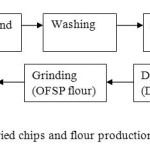 |
Figure 1: Flow chart of OFSP dried chips and flour production. Click here to View figure |
Other ingredients such as Wheat grain, Fenugreek, baker Yeast, Salt and cooking Oil were purchased from local market. The Wheat grain was manually cleaned by sifting, winnowing from dust and other impurities. It was milled in local mills and passed through a mesh size of 1mm. All ingredients were packed in safe environment until use.
Development of OFSP Flour Enriched Breads
Pretest was done ahead of the actual laboratory work to test the instruments, method of fermenting, baking and all procedures needed for the laboratory work. Blending of OFSP flour to WWF at 10, 20 and 30% was done. The amounts of ingredients required to the formulation were incorporated based on Owori et al. (2007) Eastern and Central Africa Sweet potato recipe book guideline. Fenugreek flour (1g/100g) was added to the formulation to improve the protein content of the breads. Because OFSP is poor in protein content as well as Wheat is deficient in essential amino acids such as lysine and threonine (Shalini and Sudesh, 2005). However, Fenugreek flour is rich in protein content (25%), lysins (5.7g/16gN), besides being rich in calcium, iron and β-carotene (Shalini and Sudesh, 2005). Baker Yeast (0.5g/100g) has been used as dough-leavening characteristics. Cooking Oil (0.48g/100g) was added in to the dough to soften the texture, to have a uniform cell structure and tenderizing effects up on the dough as well as to facilitate dough handling and processing. It is also important for bio availability of the β-carotene rich breads. Salt (1g/100g) was also incorporated to the formulated dough. The ingredients were locally available and adapted in the study area for bread makings. All measured ingredients, were mixed in bowl until the mixture becomes uniform. Lukewarm water was added slowly while mixing and kneading the dough. The dough was kneaded for 20 minutes or until it was smooth, non sticky and elastic. Lastly cooking Oil was added to the formulation while kneading. Then the dough was covered and left to rise at room temperature for 6 hours. After rising, the dough was sheeted and baked in an electric stove (‘Mitad’) as usual traditional baking system. However, to make the traditional baking system adoptive standard, the temperature of the stove was measured. Then the sample breads were baked at constant time (10 minutes) and maximum temperature of 78 oc. When baking completed, the bread was removed and cool for few minutes at room temperature. A control was processed without addition of OFSP flour. All samples were mixed, fermented and baked in the same manner and procedure (Figure 2).
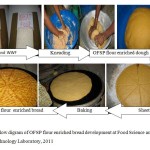 |
Figure 2: Flow diagram of OFSP flour enriched bread development at Food Science and Post Harvest Technology Laboratory, 2011 Click here to View figure |
Nutrient Analysis of OFSP Flour Enriched Breads
Nutrient compositions such as moisture content, crude protein, crude fat, crude fiber and ash of the sample breads as well as flours of OFSP and Wheat were determined according to AOAC (2000) standard method at EHNRI laboratory. However, β-carotene was analyzed using Gyorgy (1950) vitamin methods (manual column chromatography). Petroleum ether was used for the extraction and the absorbance was read at 440 nm. The Trans β-carotene values were used to calculate VA contributed to the diet, expressed as retinol equivalents (RE), which was used by FAO /WHO (2002). According FAO /WHO (2002), conversion factor of 6 μg Trans β-carotene per 1 μg RE (1µg β-carotene = 0.167µg RE) was used. Moisture content was determined by oven drying a sample at 60ºC for 12 hours (AOAC, method 925.40). Protein content (% N x 6.25) was determined by the Kjedahl method (AOAC, Method 979.09). Crude fat test was carried out based on Soxhlet extraction method utilizing Diethyl ether (AOAC, Method 4.5.01). The ash content was measured according to dry ashing procedure (AOAC, Method 941.12) while dietary fiber was determined according to the procedure of AOAC, Method 920.169.
The content of carbohydrate with out fiber in the sample breads were determined by difference method that is by subtracting the sum of the percentages of moisture, crude protein, crude fat and ash content from 100 (Mathew and Saleh, 2006). The energy content was determined by multiplying percentages of crude fat, crude protein, and carbohydrate by factors of 9, 4 and 4, respectively (Shrestha and Noomhorm, 2002). All analyses were carried out in duplicates and in dry basis forms except β-carotene for the sample breads were in wet basis.
Data Quality Assurance
Orientation for laboratory cookers was given. Moreover, Sweet potato variety selection, washing, peeling, slicing, soaking, drying, packing of dried chips, milling, mixing of ingredients, fermenting and baking methods were checked and followed by the researcher. To ensure that these procedures were practical; the researcher and supervisors were seriously involved in the research work. Laboratory cookers worked according to a fixed schedule and clearly defined procedures. Regular follow up of laboratory activities was carried out and corrective actions were taken when deviation occurs. When ambiguous results were found during nutrient analysis repeat analysis was take place.
Statistical Analysis
Data were entered and analyzed using SPSS (version 16) and SAS (version 9) statistical software packages. One way analysis of variance (ANOVA) was used to test the main effect of proportions in the formulation at 5% level of significance. Fisher’s Least Significant Difference (LSD) at P < 0.05 was used to determine which means are significantly different. The value of β-carotene and proximate composition were calculated and the results were expressed in mean ± SD.
Results
Nutrient Content of OFSP and Whole Wheat Flours
Orange flesh sweet potato flour is rich in VA content as compared to WWF, which is devoid of VA. Flour from OFSP is also rich in fiber and ash content than WWF but low in protein content (Table 1).
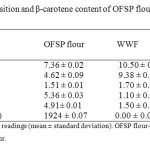 |
Table 1: Proximate composition and β-carotene content of OFSP flour and WWF per 100g, 2011 Click here to View table |
Nutrient Compositions of OFSP Flour Enriched Breads
Nutrient content of the four OFSP flour enriched breads is given in Table 2. The requirement for a 1-3 and 4-6 years old child is also given to assist the interpretation of the nutrient values per 100g of the breads. Generally, as OFSP flour proportion increased in the formulation β-carotene, fiber, moisture and ash content of the bread increased significantly (P < 0.05) but decreased in protein, fat, carbohydrate and energy (Table 2). The OFSP flour enriched breads contributed significant amount of VA to pre-school children’s daily requirement as compared to the local bread which provided small percentage contribution (Figure 3).
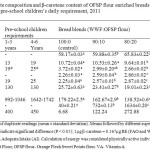 |
Table 2: Proximate composition and β-carotene content of OFSP flour enriched breads per 100g in comparison to pre-school children’s daily requirement, 2011 Click here to View table |
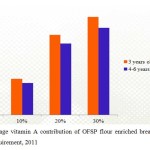 |
Figure 3: Percentage vitamin A contribution of OFSP flour enriched bread to 3-6 years old children daily requirement, 2011 Click here to View figure |
Discussions
Nutrient Analysis of Orange Flesh Sweet Potato and Whole Wheat Flours
Both Wheat and OFSP flours are easily blended ingredients for production of VA enriched breads. Because, the staple crop (Wheat) can contribute ingredients such as gluten (absent in OFSP) and protein (low in OFSP) for quality bread making (Burri, 2011 and See, 2008). In addition, OFSP also contributes primarily VA and fiber to the formulation (present result).
Flour derived from wheat is perfect for producing a wide range of confectionery and baked products (Pareyt and Delcour, 2008). However, it is poor in β-carotene content. The present study confirmed that WWF was devoid of VA, which is in agreement with the Ethiopian food composition report data (1997). In contrast to WWF, VA content of OFSP flour was highest.
Marcos et al. (2008) suggested that, the amount of total β-carotene in OFSP was high even though there is loss during boiling, storage and drying. This indicated that, flour from OFSP has potential as a significant source of VA. Therefore, adding OFSP flour to locally available ingredient (WWF) for bread making improves VA content of the local breads. Low VA content (1596 µg RE/100g) of OFSP flour dried by direct sun light was found by Bechoff (2007), which is low as compared to the present study. Selection of cultivars and drying environment might be the reason for the absorbed difference. Moreover, the OFSP flour contained appreciable amounts of minerals, as can be inferred from its mean ash content (5.36%) compared to that of WWF (1.1%).
A crude fiber level of OFSP flour was analyzed to be 4.91% which was greater than WWF (1.5%). Both ash and fiber results had similar pattern with the reports of Abinet (2009) who did on Taro and Wheat flours. The level of crude protein in OFSP flour was lower than that of WWF, which is agreed with the Ethiopian food composition (1997).
The moisture content of OFSP flour was found to be 7.36% which was lower than WWF (10.5%). Abinet (2009) reported a similar finding in Taro and Wheat flour. On a similar work but higher moisture content of OFSP flour (9.8-11.2%) was found by Bechoff (2007). Selection of different OFSP cultivars and maturation of the crop might be the reasons for the observed differences.
Nutrient Compositions of OFSP Flour Enriched Breads
General trends of the nutrient analysis showed that protein, fat, carbohydrate and energy content decreased as blending level of OFSP flour increased, while moisture, ash, fiber and β-carotene increased as proportion of OFSP flour increased in the formulation. Moisture content of the prepared breads was increased, as blending level of OFSP flour increased. Lowest and highest moisture content was found from local bread and 30% OFSP flour contained bread, respectively. Similarly, Wang and Kays (2001) described that, higher total fiber in the non-Wheat flour interact relatively well with a large amount of water through the hydroxyl group existing in the fiber structure. Mansour et al. (1999) also reported that, addition of pumpkin and canola proteins to Wheat flour resulted in an increase in water absorption.
Protein content of OFSP flour enriched breads was lower than control bread. The test breads ranged from 8.95 to 10.72% of protein levels. As expected, the bread with the highest percentage of WWF (100% WWF) had the highest protein content. This decrease might be due to the low protein content of the OFSP flour (4.62%) compared to WWF (9.38%). However, the protein level of the control (10.72%) in the present study is better than the Ethiopian food composition reports for Wheat bread (6.80%). This is probably due to the addition of Fenugreek which has high amount of protein (19.3%) (Ethiopian food composition, 1997). Difference in wheat variety and method of preparation may be also other reason for the observed variations.
Greene and Bowell-Benjamin (2004) found a protein level ranged from 8.5 to 6.9% for WWF formulated with 50 to 60% of OFSP flour, respectively. In addition, Okorie et al. (2002) reported that protein values ranging from 7.6 to 11.6% for breads made from Wheat, potato and cocoyam. Lyimo (2007) reported that in composite flour formulations of Sweet potato, Wheat and soybean for bread making was found highest protein level (12.2%). This high protein level might be due to addition of soybean, which is rich in protein.
Fat content of the formulated breads ranged from 2.32 to 3.72%. Substituting higher levels of OFSP flour in the formulation reduces the fat content. This was due to the lower fat content in OFSP flour as compared to the Wheat flour as mentioned by Lyimo (2007). The fat contents were similar to those of Lyimo (2007). In contrast, Okorie et al. (2002) reported lower fat values ranging from 1.1 to 1.6% for breads made from Wheat, potato and cocoyam. Hence, incorporation of OFSP flour in bread resulted in reduction of Wheat protein, and fat content due to the declining amount of WWF in the formulation, in agreement with those reported by See et al. (2007).
The crude fiber was observed to differ significantly between bread of the control and OFSP flour enriched breads. This was due to more fiber content in OFSP than Wheat as mentioned by Anthon (2008) and Singh et al. (2008). The ash compositions in the OFSP flour enriched breads were found to be significantly higher as compared to those of the control. This entails that incorporation of OFSP flour in the process of bread making could enhance the mineral intake, as ash is indicative of the amount of minerals contained in any food sample (Olaoye et al., 2007). Similar result was reported by Greene and Bowell-Benjamin (2004). Okorie et al. (2002) found lower ash values ranging from 1.2 to 2.9% for breads made from Wheat, potato and cocoyam.
Increase in substitution of OFSP flour to WWF showed reduction in both carbohydrate and energy content of the breads. This indicated that WWF was the main contributor to the carbohydrate content in bread. This result is similar to those reported by Greene and Bowell-Benjamin (2004), mean carbohydrate values ranged from 18.2 to 24.4%. With an increase in the proportion of OFSP flour, a decrease in the gross energy level was observed. This might be due to decrease in fat, protein and carbohydrate content in the formulation when Wheat proportion was reduced.
The OFSP flour can retaine β-carotene and contributed significant amount of VA; even if it had passed through many processings such as drying, storage and baking. These findings were consistent with Greene and Bowell-Benjamin (2004). The local bread (control) has provided insignificant amount of VA content as compared to OFSP flour enriched breads. This indicated that OFSP is rich in β-carotene content, which is basically very low in WWF. A similar result was also reported by Van-Hal (2000).
Owori and Hagenimana (2000) substituted Wheat flour up to 30% OFSP flour for Mandazi making and 100g of mandazi could meet 40% of the recommended intake of provitamin A for children, which was low as compared to the present study result (83.5%). This observed variation might be due to difference in type of product, variety and processing methods used in the formulation. Kosambo (2004) reported 30% of the recommended intake of provitamin A for children from 100g of Jonathan Sweet potato variety flour enriched porridge. In the present study, OFSP flour contained breads contributed significant amount of VA in the diet of pre-school children.
Analysis of all the sample breads was from 100g; hence all formulated breads did not fulfill the daily nutrient requirements of pre-school children. However, daily requirement can fulfill by increasing pre-school children’s consumption frequency of the formulated breads (increase portion size of the formulated breads). However, it might not be must to get the child’s daily requirements from one types of food (bread). For example, in the present study, the pre-school children RDA can be fulfilled 25-70% from breads which were enhanced with 10-20% OFSP flour. The rest requirement can be covered from other VA rich food sources.
Conclusion
The present study attempted the possibility of using OFSP flour for the production of VA enriched breads by blending with locally available Wheat flour, it explores affordable option i.e. food based intervention which has a long term solution to alleviate VAD in pre-school children. Flour from OFSP can be blended with WWF to produce nutritious bread products with increased VA content. The bulky and perishable nature of OFSP tuber can be dried to stable flake that can be consumed year round to reduce post harvest loss and alleviate VAD.
Bread enriched with 30% OFSP flour can contribute 83.3 and 74.2% of VA to 3 and 4-6 years old children’s daily requirement, respectively. Generally, the OFSP flour enriched breads provided significant amount of VA to pre-school children daily requirement as compared to the local bread.
A general trend of nutrient analysis of the prepared breads showed that protein, fat, carbohydrate and energy content decreased significantly (P < 0.05) as bread containing OFSP flour increased, while moisture, ash, fiber, β-carotene increased significantly (P < 0.05) as proportion of OFSP flour increased.
Recommendations
- The use of OFSP flour-WWF blends in bread formulation appeared to be promising from nutritional point of view as compared to the local breads.
- Orange flesh sweet potato is poor in protein; therefore addition of Fenugreek as protein enrichment is encouragable.
- Drying and utilization of OFSP in flour form is recommended for post harvest loss reduction, storage, year round use and alleviation of VAD.
- The newly formulated breads can be used as valuable formula for the development of high fiber low gluten breads, particularly for those who have allergy of Wheat.
- Bioavailability of OFSP flour enriched breads needs further investigation.
Acknowledgements
I am most grateful to Dr. Fetien Abay, NUFU/WFS project coordinator, Mekelle University. I would also like to extend my thanks to donor organizations WFS/Mekelle University and CIP-USAID for their full coverage of all costs. Finally I am highly thankful to Hawassa University, Mekelle University and EHNRI laboratories, which gave me permission to prepare samples and their nutritional analysis.
References
- Abinet Tekle. 2009. The effect of blend proportion and baking condition on the quality of cookies made from taro and Wheat flour blend. MSc. thesis dissertation, Addis Ababa University, Ethiopia.75 p.
- Assefa Tofu, Teshome Anshebo, Engida Tsegaye & Tesfaye Tadesse. 2007. Summary of progress on Orange fleshed sweet potato research and development in Ethiopia. Proceedings of the 13th ISTRC Symposium, 2007, Ethiopia. pp 728-73
- Association of Official Analytical Chemists (AOAC). 2000. Official Method of Analysis, 16th Edition. Washington, DC.
- Bechoff A., Dufour D., Dhuique-Mayer C., Marouze C., Reynes M. & Westby A. 2008. Effect of hot air, solar and sun drying treatments on provitamin A retention. Journal of Food Engineering, 84:272-280.
- Burri B.J. 2011. Evaluating Sweet potato as an intervention food to prevent vitamin A deficiency. Comprehensive Reviews in Food Science and Food Safety, 10: 118-130.
CrossRef - Ethiopian food composition. 1997. Food composition table for use in Ethiopia, part III. A research project sponsored by the government of Ethiopia through former Ethiopian Nutrition Institute (ENI) and EHNRI. 34 p.
- FAO (Food and Agricultural Organization). 2008. Guideline for measuring household and individual dietary diversity. FAO nutrition and consumer protection division with support from the EC/FAO food security information for action programme and the Food and Nutrition Technical Assistance Project. Version 4, December, 2008. Rome, Italy.
- Greene J.L. & Bovell-Benjamin A.C. 2004. Macroscopic and sensory evaluation of bread supplemented with Sweet potato flour. Journal of Food Science, 69 (4):167-173.
- Gyorgy P.1950. Vitamin methods. Academic press, New York. 57 p.
- Jalal F., Nesheim M.C., Agus Z., Sanjur D. & Habicht J.P. 1998. Serum retinol concentrations in children are affected by food sources of β-carotene, fat intake, and anthelminthic drug treatment. American Journal of Clinical Nutrition, 68:623-629.
CrossRef - Jemal Haidar, Tsegaye Demisse, Haile-Michael Gebre-Sillasie, Habtamu Fufa, Eskinder Biratu & Hana Nekatibeb. 1996. Vitamin A deficiency status in Tigray Region. Ethiopian Health and Nutrition Research Institute, Addiss Ababa, Ethiopia. Ethiopian Journal of Health Development, 13(2):87-91.
- Kosambo L. 2004. Effect of storage and processing on all trans-β carotene content in fresh Sweet potato (Ipomoea batatas Lam) roots and its products. CIP Funded Research Project: Annual Report (July 2003-June 2004). Kenya Industrial Research and Development Institute, Nairobi. 11p.
- Lyimo M.E., Gimbi D.M. & Shayo N.B. 2007. Nutritional evaluation of composite flour based on root and tuber crops and sensory acceptability of the developed products. Proceedings of the 13th ISTRC symposium, May 2007, Sokoine University of Agriculture, Department of Food Science and Technology, Faculty of Agriculture, Morogoro, Tanzania. pp 514-520.
- Mansour E.H., Dworschak E., Pollhamer Z., Gergely A. & Hovari J. 1999. Pumpkin and canola seed proteins and bread quality. Acta Alimentaria, 28: 59-70.
- Marcos J.O., Antonio G.S., Murillo F.J., Dejair L.A. & Jose L.R. 2008. Effect of extrusion cooking in total carotenoids contents in Cream and Orange flesh sweet potato cultivars. Horticultural Brasilas, 26 (1):187-198.
- Mathew B.K. & Saleh B.B. 2006. Selected physicochemical properties of flour from the root of African Fan Palm (Borassus aethiopum). Internationa Journal of Food Properties, 9(4): 701-713.
CrossRef - Olaoye O.A., Onilude A.A. & Oladoye C.O. 2007. Breadfruit flour in biscuit making: Effects on product quality. African Journal of Food Science, 18:20-23.
- Okorie S.U., Ndukwe C.U & Umekwe E.L. 2002. Utilization and evaluation of Wheat, potato and cocoyam flour composite for bread preparation. Journal of Food Science Technology, 39:686-689.
- Owori C. & Hagenimana V. 2000. Quality evaluation of Sweetpotato flour processed in different agroecological sites using small scale processing technologies. African Potato Association Conference Proceedings January 5, 2000, Kampala, Uganda. pp 483-490.
- Pareyt B. & Delcour J.A. 2008. The role of Wheat flour constituents, sugar, and fat in low moisture cereal based products: A review on sugar-snap cookies. Journal of Critical Review in Food Science and Nutrition, 48(9):824-839.
CrossRef - See E.F., Wan N.W. & Noor A.A. 2007. Physico-chemical and sensory evaluation of breads supplemented with pumpkin flour. Asean Food Journal, 14 (2): 123 -130.
- See E.F. 2008. Physico-chemical and organoleptic evaluations of Wheat bread substituted with different percentage of pumpkin flour (cucurbita moschata). MSc.Thesis. University of Sains, Malaysia. 86 pp.
- Shalini H. & Sudesh J. 2005. Effect of Fenugreek flour blending on physical, organoleptic and chemical characteristics of Wheat bread. Journal of Nutrition and Food Science.35 (4):229- 242.
CrossRef - Shrestha A.K. & Noomhorm, A. (2002). Comparison of physico-chemical properties of biscuits supplemented with Soy and Kinema flour. International journal of food science and nutrition, 37: 361-368.
CrossRef - Singh S., Riar C.S. & Saxena D.C. 2008. Effect of incorporating Sweetpotato flour to Wheat flour on the quality characteristics of cookies. African Journal of Food Science, (2): 65-72.
- Tarik Kassaye, Receveur O., Johns.T & Margaret R.B. 2001. Prevalence of VAD in children aged 6 – 9 years in Wukro, Northern Ethiopia. Bulletin of the WHO (2001), 79 (5): 224-229.
- Tsegaye demissie, Ahmed Ali, Yared Mekonen, Jemal Hiader & Meleaku Umeta. 2010. Magnitude and distribution of vitamin A deficiency in Ethiopia. Ethiopian Health and Nutrition Research Institute, Addis Ababa, Food nutrition Bulltin, 31 (2): 234-241.
CrossRef - Van-Hal M. 2000. Quality of Sweet potato flour during processing and storage. Food Reviews International, 16:1-37.
CrossRef

This work is licensed under a Creative Commons Attribution 4.0 International License.




